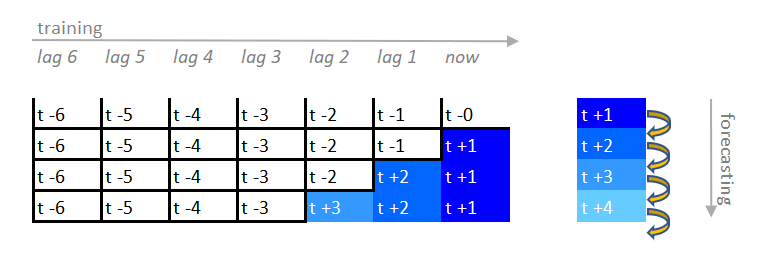Ecosyste.ms: Awesome
An open API service indexing awesome lists of open source software.
https://github.com/cerlymarco/tspiral
A python package for time series forecasting with scikit-learn estimators.
https://github.com/cerlymarco/tspiral
autoregressive-forecasters autoregressive-modeling direct-forecasting exogenous-predictors forecasting multivariate-forecasting multivariate-timeseries python recursive-forecasting scikit-learn time-series timeseries timeseries-forecasting
Last synced: 1 day ago
JSON representation
A python package for time series forecasting with scikit-learn estimators.
- Host: GitHub
- URL: https://github.com/cerlymarco/tspiral
- Owner: cerlymarco
- License: mit
- Created: 2022-07-12T13:07:38.000Z (over 2 years ago)
- Default Branch: main
- Last Pushed: 2024-04-04T14:53:33.000Z (10 months ago)
- Last Synced: 2024-10-11T21:43:40.844Z (3 months ago)
- Topics: autoregressive-forecasters, autoregressive-modeling, direct-forecasting, exogenous-predictors, forecasting, multivariate-forecasting, multivariate-timeseries, python, recursive-forecasting, scikit-learn, time-series, timeseries, timeseries-forecasting
- Language: Jupyter Notebook
- Homepage:
- Size: 2.73 MB
- Stars: 160
- Watchers: 6
- Forks: 20
- Open Issues: 0
-
Metadata Files:
- Readme: README.md
- License: LICENSE
Awesome Lists containing this project
README
# tspiral
A python package for time series forecasting with scikit-learn estimators.
tspiral is not a library that works as a wrapper for other tools and methods for time series forecasting. tspiral directly provides scikit-learn estimators for time series forecasting. It leverages the benefit of using scikit-learn syntax and components to easily access the open source ecosystem built on top of the scikit-learn community. It easily maps a complex time series forecasting problems into a tabular supervised regression task, solving it with a standard approach.
## Overview
tspiral provides 4 optimized forecasting techniques:
- **Recursive Forecasting**
Lagged target features are combined with exogenous regressors (if provided) and lagged exogenous features (if specified). A scikit-learn compatible regressor is fitted on the whole merged data. The fitted estimator is called iteratively to predict multiple steps ahead.

Which in a compact way we can summarize in:

- **Direct Forecasting**
A scikit-learn compatible regressor is fitted on the lagged data for each time step to forecast.

Which in a compact way we can summarize in:

It's also possible to mix recursive and direct forecasting by predicting directly some future horizons while using recursive on the remaining.

- **Stacking Forecasting**
Multiple recursive time series forecasters are fitted and combined on the final portion of the training data with a meta-learner.

- **Rectified Forecasting**
Multiple direct time series forecasters are fitted and combined on the final portion of the training data with a meta-learner.

**GLOBAL and MULTIVARIATE time series forecasting are natively supported for all the forecasting methods available.** For GLOBAL forecasting, use the `groups` parameter to specify the column of the input data that contains the group identifiers. For MULTIVARIATE forecasting, pass a target with multiple columns when calling fit.
## Installation
```shell
pip install --upgrade tspiral
```
The module depends only on NumPy, Pandas, and Scikit-Learn (>=0.24.2). Python 3.6 or above is supported.
## Media
- [How to Improve Recursive Time Series Forecasting](https://medium.com/towards-data-science/how-to-improve-recursive-time-series-forecasting-ff5b90a98eeb)
- [Time Series Forecasting with Feature Selection: Why you may need it](https://medium.com/towards-data-science/time-series-forecasting-with-feature-selection-why-you-may-need-it-696b23ecc329)
- [Forecast Time Series with Missing Values: Beyond Linear Interpolation](https://medium.com/towards-data-science/forecast-time-series-with-missing-values-beyond-linear-interpolation-2f2adf0a0cba)
- [Time Series Forecasting with Conformal Prediction Intervals: Scikit-Learn is All you Need](https://medium.com/towards-data-science/time-series-forecasting-with-conformal-prediction-intervals-scikit-learn-is-all-you-need-4b68143a027a)
- [Hitting Time Forecasting: The Other Way for Time Series Probabilistic Forecasting](https://medium.com/towards-data-science/hitting-time-forecasting-the-other-way-for-time-series-probabilistic-forecasting-6c3b6496c353)
- [Hitchhiker’s Guide to MLOps for Time Series Forecasting with Sklearn](https://medium.com/towards-data-science/hitchhikers-guide-to-mlops-for-time-series-forecasting-with-sklearn-d5d9728095a7)
## Usage
- **Recursive Forecasting**
```python
import numpy as np
from sklearn.linear_model import Ridge
from tspiral.forecasting import ForecastingCascade
timesteps = 400
e = np.random.normal(0,1, (timesteps,))
y = np.concatenate([
2*np.sin(np.arange(timesteps)*(2*np.pi/24))+e,
2*np.cos(np.arange(timesteps)*(2*np.pi/24))+e,
])
X = [[0]]*timesteps+[[1]]*timesteps
model = ForecastingCascade(
Ridge(),
lags=range(1,24+1),
groups=[0],
).fit(X, y)
forecasts = model.predict([[0]]*80+[[1]]*80)
```
- **Direct Forecasting**
```python
import numpy as np
from sklearn.linear_model import Ridge
from tspiral.forecasting import ForecastingChain
timesteps = 400
e = np.random.normal(0,1, (timesteps,))
y = np.concatenate([
2*np.sin(np.arange(timesteps)*(2*np.pi/24))+e,
2*np.cos(np.arange(timesteps)*(2*np.pi/24))+e,
])
X = [[0]]*timesteps+[[1]]*timesteps
model = ForecastingChain(
Ridge(),
n_estimators=24,
lags=range(1,24+1),
groups=[0],
).fit(X, y)
forecasts = model.predict([[0]]*80+[[1]]*80)
```
- **Stacking Forecasting**
```python
import numpy as np
from sklearn.linear_model import Ridge
from sklearn.tree import DecisionTreeRegressor
from tspiral.forecasting import ForecastingStacked
timesteps = 400
e = np.random.normal(0,1, (timesteps,))
y = np.concatenate([
2*np.sin(np.arange(timesteps)*(2*np.pi/24))+e,
2*np.cos(np.arange(timesteps)*(2*np.pi/24))+e,
])
X = [[0]]*timesteps+[[1]]*timesteps
model = ForecastingStacked(
[Ridge(), DecisionTreeRegressor()],
test_size=24*3,
lags=range(1,24+1),
groups=[0],
).fit(X, y)
forecasts = model.predict([[0]]*80+[[1]]*80)
```
- **Rectified Forecasting**
```python
import numpy as np
from sklearn.linear_model import Ridge
from sklearn.tree import DecisionTreeRegressor
from tspiral.forecasting import ForecastingRectified
timesteps = 400
e = np.random.normal(0,1, (timesteps,))
y = np.concatenate([
2*np.sin(np.arange(timesteps)*(2*np.pi/24))+e,
2*np.cos(np.arange(timesteps)*(2*np.pi/24))+e,
])
X = [[0]]*timesteps+[[1]]*timesteps
model = ForecastingRectified(
[Ridge(), DecisionTreeRegressor()],
n_estimators=24*3,
test_size=24*3,
lags=range(1,24+1),
groups=[0],
).fit(X, y)
forecasts = model.predict([[0]]*80+[[1]]*80)
```
More examples in the [notebooks folder](https://github.com/cerlymarco/tspiral/tree/main/notebooks).